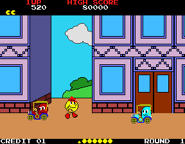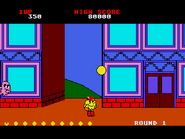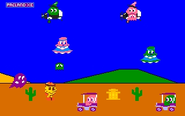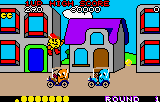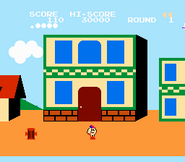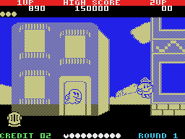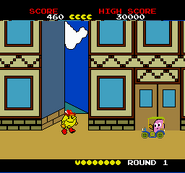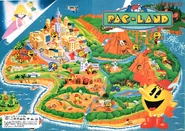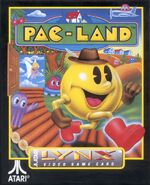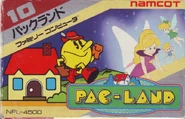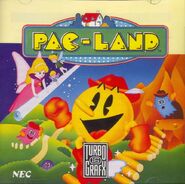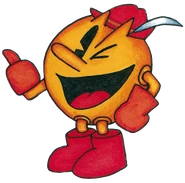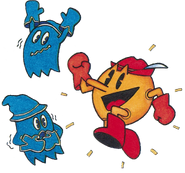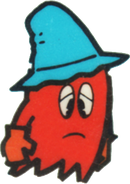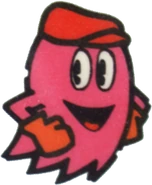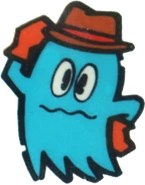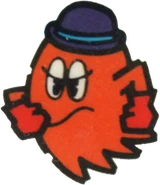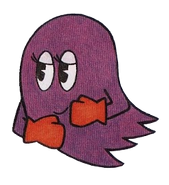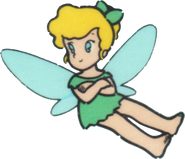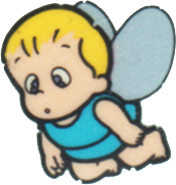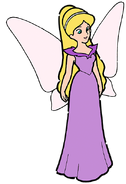- For the location Pac-Land, see Pac-Land (place).
Pac-Land (パックランド Pakku-Rando) is an arcade game released by Namco in 1984. It is the first platformer in the Pac-Man series.
Gameplay
Pac-Land is a side-scrolling platformer, where the objective is to get from one side of the screen to the other. The player controls Pac-Man, who must travel through Pac-Land to return a Fairy (who is underneath Pac-Man's hat) to Fairyland.
Each trip has four rounds - the first three to get to Fairyland, and the fourth to head back. Starting at his house, Pac-Man will travel through towns, forests, mountains and more as he delivers the lost fairy back to its mother. Generally these are fairly straightforward paths, going from left to right (right to left on each fourth round), aside from the many obstacles in Pac-Man's way.
Every time one of the first three stages is completed, a sign labeled "BREAK TIME" will appear; Pac-Man can jump in these segments in-time to the music, and he will get a certain number of points depending on his jump's distance from the ground.
Once Pac-Man reaches Fairyland in the fourth stage, he is greeted by the Mother Fairy, who gives him magical boots that allow him to fly. He travels back home, to which he is greeted by Ms. Pac-Man, Baby Pac-Man, Chomp-Chomp and Sour Puss. Directly after this, the next set of rounds start, and the process repeats until all lives are lost.
Enemies and Obstacles
Along the way on his journey, the Ghost Gang do their best to stop Pac-Man. Blinky, Inky, Pinky, and Clyde now ride in different machines in attempt to ambush Pac-Man, including cars, buses, UFOs, and planes. Plane ghosts are particularly dangerous, as they throw micro-ghosts down at Pac-Man which are hard to avoid. Ghosts can appear in building windows as well, serving the same function as plane ghosts.
Sue also appears, but she just chases Pac-Man from behind if he is walking in the opposite direction - that is, unless the timer runs out, in which Sue goes super fast and will kill Pac-Man in one hit. As with previous games, ghosts can be eaten if Pac-Man eats a Power Pellet.
Pac-Man will encounter many non-Ghost obstacles as well, including:
- Fire Hydrants, Tree Stumps, Cacti - All serve the same purposes. Easily jumped over, and some can provide power-ups when pushed. In later levels, fire hydrants may shoot water at Pac-Man, which propels him forward.
- Log Platforms - Platforms that go up and down. Must be jumped on carefully to avoid falling in a pit.
- Log Bridges - Platforms that fall down when Pac-Man walks on them. The player must go very quickly or else he will fall.
- Clouds - Very tiny platforms that are easy to fall off of.
- Antlion - Skulls that indicate where quicksand is located, which Pac-Man will sink into if he stands for too long.
- Ponds - One of the most challenging parts of the game. Pac-Man jumps on a spring-loaded diving board directly in front of a pond, and must keep pressing the button quickly to pass over the entire body of water. If the button is not pressed enough times, or the player jumped too early/too late, Pac-Man will drown.
Later in the game, two entirely different kinds of levels appear - Sunken Ships and Castles - which are loaded with obstacles of their own. Sunken ships require the player to make precision-perfect jumps over thin planks; to make some jumps, Pac-Man will need to collect ship symbols, which make the planks longer. Castle levels feature three paths, and many locked doors, which require keys to be opened. If Pac-Man takes too long, Sue will run out and attack him. Some of these levels are in complete darkness as well, making them even harder.
Items
Many items appear throughout the game, which include:
- Power Pellet - Allows Pac-Man to eat the ghosts.
- Helmet - Can be used to dodge micro-ghosts.
- Lucky Pac - The player will receive a time bonus.
- Special Pac - Pac-Man gets an extra life.
- Ship - Extends the length of the planks in the Sunken Ship levels.
- Key - Required to open doors in the Castle levels.
- Galaxian - Awards 7650 points.
- Balloons - A bunch of balloons pop out, which can be collected for bonus points.
- Flower - A mysterious power-up that seems to have no function whatsoever. It only appears on level 1.
Fruits also make a return, which appear throughout the stage(s). As more are collected, their point value increases (until four have been eaten, in which it resets the same pattern). These are the fruits that appear, next to their sequential point value:
- Cherry - 100, 300, 500, 1000 points
- Strawberry - 300, 500, 1000, 1500 points
- Orange - 500, 1000, 1500, 2000 points
- Apple - 1000, 1500, 2000, 2500 points
- Melon - 1500, 2000, 2500, 3000 points
TV Series connections
Pac-Land was heavily inspired by the Pac-Man TV series, with many references to it. The most obvious connection is the music, which is an 8-bit rendition of the cartoon's theme song. Some of the game's other tracks, like the one that plays in the Castle levels, is background music lifted the show as well. Pac-Man and the ghosts also dawn hats like their Hanna-Barbera counterparts.
In the Bally Midway U.S. release, even more visual connections were added that directly reference the TV series - all of the Pac-Men have white circles around their eyes, Pac-Man's hat looked more like a fedora, Ms. Pac-Man was given brown hair, Baby Pac-Man's bow was colored blue, and Chomp-Chomp and Sour Puss were added to the ending screen, both of whom are completely absent in the Japanese version.
Home Ports
- Amiga
- Amstrad CPC
- Atari Lynx
- Atari ST
- Commodore 64
- Famicom/NES
- Handheld LCD Games
- iOS (iPhone, iPad, etc.) - now defunct
- MSX
- PC Engine/TurboGrafx-16
- PlayStation
- PlayStation 3
- Sharp X68000
- Wii U
- Windows PC
- Xbox 360
A special edition (?) release of the Sharp X68000 version came with a special three-button controller matching the layout of the arcade machine.[1] The handheld LCD game is a fairly loose adaption - somewhat a clone of the Super Mario Bros. Game & Watch - and does not have many of the arcade game's features.
A release of Pac-Land was planned for the Atari 8-bit computer series (400, 800, XL and XE), but never got passed conceptual stages. A prototype was built, but it only featured minimal coding with mock-up screenshots.[2]
The PC Engine/TurboGrafx-16 port features a special, more challenging game mode called Pac-Land Pro. It is unlocked by beating the game and viewing the ending. Alternatively, it can be started via the cheat code below:
- Enter the Options menu by holding down I and II while pressing Start;
- Enable the "SKIP" option;
- Press Start at the title screen, then press Up ten times.
Console releases of Pac-Land are less common than the other (Namco-owned) Pac-Man games, which is speculated to be due to Hanna-Barbera (now technically Warner Bros.) owning the music tracks.
Trivia
- Several regional revisions of the game, including the United States release, run considerably faster than the Japanese original. All home ports of the game still played at the Japanese version's speed.
- The exact opposite happened when localizing Super Pac-Man, in which the overseas versions ran slower after eating a Super Pellet.
- A stage based on Pac-Land appears in Super Smash Bros. for Nintendo 3DS / Wii U and Super Smash Bros. Ultimate.
- Pac-Man Monsters features an event quest based off of Pac-Land, known as "Welcome to Pac-Land". The quest takes place in the game's first area, Pac-Town, which is based off of the town area from Pac-Land. The Ghost Gang are encountered as enemies, driving in vehicles like in the original game. The final boss of the quest, King of Ant Lion, is based off the skulls encountered in the desert areas.
- Shigeru Miyamoto, the creator of Mario, has reportedly stated that Pac-Land was the direct inspiration for the original Super Mario Bros. Miyamoto has never said it directly, however - only in private conversations with Toru Iwatani.[3]
Gallery
Screenshots
Machine and Box Art
Character Artwork
References
- ↑ http://thumb3.zeppy.io/d/l400/pict/222931211786/pac-man-pac-land-x68000-3-button-pad-controller-computer-vintage
- ↑ https://web.archive.org/web/20030408165426/http://www.jetbootjack.com/Pacland.htm
- ↑ "Mr. Shigeru Miyamoto, who developed 'Super Mario Bros.' told me that the game was influenced by Namco’s 'PAC-LAND'." https://geekculture.co/interview-with-toru-iwatani-creator-of-pac-man/

